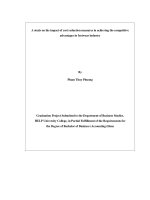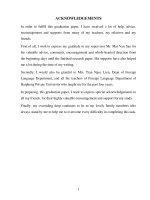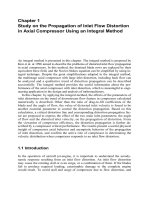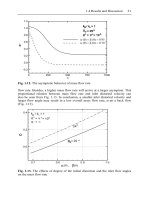A cross-sectional study on the occurrence of Coxiella Burnetii infection in a dairy farm, Bareilly, India
Bạn đang xem bản rút gọn của tài liệu. Xem và tải ngay bản đầy đủ của tài liệu tại đây (183.16 KB, 6 trang )
Int.J.Curr.Microbiol.App.Sci (2019) 8(2): 2102-2107
International Journal of Current Microbiology and Applied Sciences
ISSN: 2319-7706 Volume 8 Number 02 (2019)
Journal homepage:
Original Research Article
/>
A Cross-sectional Study on the Occurrence of Coxiella burnetii Infection in
a Dairy Farm, Bareilly, India
Manesh Kumar1*, Satyaveer Singh Malik1, Sunitha Ramanjeneya1,
Radhakrishna Sahu1, Jess Vergis1, Richa Pathak1, Pankaj Dhaka1, Jay Prakash Yadav1,
Sukhadeo Baliram Barbuddhe2 and Deepak Bhiwa Rawool1*
1
Division of Veterinary Public Health, ICAR- Indian Veterinary Research Institute,
Uttar Pradesh- 243 122, India
2
ICAR- National Research Centre on Meat, Chengicherla, Telangana- 500 092, India
*Corresponding author
ABSTRACT
Keywords
Coxiella burnetii, Q
fever, Cattle, Dairy
farm, PCR
Article Info
Accepted:
15 January 2019
Available Online:
10 February 2019
Q fever is highly infectious bacterial zoonoses caused by Coxiella burnetii and remains
largely neglected and underreported in various states of India. The present cross-sectional
study employing a simple random sampling approach analysed a total of 324 samples (108
blood, 108 sera and 108 vaginal swabs) from cattle (n=108) employing of PCR and ELISA
of cattle dairy farm from Bareilly, Uttar Pradesh, India. Besides, 18 environmental samples
(animal feed-05, soil-04, drainage water-05 and drinking water-04) from the premises of
the farm were also collected. On screening of cattle samples by trans-PCR and com1-PCR
revealed positivity for C. burnetii DNA in 9.25% (10/108) and 5.55% (6/108) samples of
cattle blood; 12.03% (13/108) and 5.55% (6/108) of sera, and 12.96% (14/108) and
06.48% (7/108) of vaginal swabs, respectively. Screening of cattle on the farm by
commercial i-ELISA kit revealed antibodies against C. burnetii in the serum samples of
14.81% (16/108) cattle population.
Introduction
Q fever is a highly infectious disease of great
public health importance caused by obligate
intracellular, Gram negative bacterium
Coxiella burnetii, which can successfully
infect hosts ranging from mammals including
domestic animals, humans and wildlife as
well as reptiles, fish, birds, ticks and
arthropods (Angelakis and Raoult, 2010;
Cutler et al., 2010; Vanderburg et al., 2014;
Eldin et al., 2017).
The C. burnetii infections in animals
generally known as 'Coxiellosis' are
widespread in domestic ruminants, which
serve as the major reservoirs of the pathogen.
The disease in ruminants is frequently subclinical, but late abortions, stillbirths and
reproductive disorders can occasionally be
observed (Maurin and Raoult, 1999; ArricauBouvery and Rodolakis, 2005). The potential
risk arising from cattle has found greater than
that from small ruminants, as cattle not only
excreted more number of pathogens but their
2102
Int.J.Curr.Microbiol.App.Sci (2019) 8(2): 2102-2107
shedding in milk also lasted for a longer
period (Rodolakis et al., 2007).
Due to the limited diagnostic capacities,
epidemiological studies on Q fever in India in
general are very few (Vaidya et al., 2010;
Malik et al., 2013; Stephen et al., 2014;
Kumar et al., 2017; Mohan et al., 2017;
Dhaka et al., 2017, Sahu et al., 2018). It is in
this context that the present study was
envisaged to assess the occurrence of Q fever
in a dairy farm, Bareilly, Uttar Pradesh, India.
Materials and Methods
A cross-sectional study with simple random
sampling was conducted in a dairy farm of
Bareilly district, Uttar Pradesh, India. A total
of 324 samples (108 blood, 108 sera and 108
vaginal swabs) were collected from 108 cattle
for screening of C. burnetii infection in the
dairy herd. Additionally, 18 environmental
samples (animal feed-05, soil-04, drainage
water-05 and drinking water-04) from the
premises of the farm were also collected for
detection of C. burnetii. All the samples were
aseptically collected in sterile containers and
were transported to laboratory under chilled
conditions. Blood, vaginal swabs and
environmental samples were stored at
refrigeration temperature, while, serum
samples were stored at -20°C until further
use.
Genomic DNA was isolated and purified from
the blood samples of both cattle and human
using Qiagen blood and tissue kit (Qiagen,
Germany) as per the manufacturer's
instructions. The processing of vaginal swab
samples for screening by PCR assay was
carried out as described by Berri et al.,
(2000), according to which a simple boiling
method was sufficient for DNA extraction
from the vaginal swabs for analyzing it by
PCR assay. It is noteworthy here that the
boiling inactivates C. burnetii in sample,
minimizes the risk to the laboratory
personnel, and also remains an inexpensive
procedure compared to other methods (Berri
et al., 2000). In brief, a sample of genital
swab was vigorously shaken in 1 ml of PBS
solution. The solution (200 μl) was then
boiled for 10 min and centrifuged at 13,000 x
g for 5 min and then collected supernatant
was used for the PCR assays. The
environmental and feed samples were
processed as per the method described by
Fitzpatrick et al., (2010). In brief, 5 g of
samples were mixed with 10 to 30 ml of
Phosphate buffer saline (PBS) solution to
create homogenized slurry, which was kept
for 1 h at room temperature and then
centrifuged for 5 min at 123 xg. The
supernatant was removed and centrifuged at
20,000 xg for 15 min. The supernatant was
then carefully discarded and the pellet was resuspended in 1 ml of PBS solution. Finally,
700 μl of the re-suspended pellet was
processed for DNA extraction using Qiagen
Stool kit (Qiagen, USA). Following DNA
extraction, purity of extracted DNA was
checked using a Biospectrometer (Eppendorf
GmbH, Germany). DNA with an absorption
ratio (A260/A280) of more than or equal to 1.80
were desirable for PCR assay. The DNA of
standard C. burnetii Nine Mile strain was
thankfully received from Dr. Eric Ghigo,
URMITE-IRD, Faculté de Médecine, France.
The detection of pathogen in all the collected
samples was carried out by PCR employing
trans and com1 genes. The trans-PCR assay
was performed targeting transposons-like
regions in chromosomal DNA using, trans-1
(5’-TAT GTA TCC ACC GTA GCC AGT C3’) and trans-2 (5’-CCC AAC AAC ACC
TCC TTA TTC-3’) with an expected
amplicon size of 687 bp (Berri et al., 2000)
while, com1-PCR was performed using
primers
com
1-F
(5’AGTAGAAGCATCCCAAGC
ATTG-3’)
and com 1-R (5’TGCCTGCTAGCTGT
2103
Int.J.Curr.Microbiol.App.Sci (2019) 8(2): 2102-2107
AACGATTG -3’) with an expected amplicon
size of 501 bp (Zhang et al., 1998). The
cycling conditions for trans 1 and 2 primers
were standardised at 94oC for 5 min (initial
denaturation), followed by 40 cycles of 94oC
for 30 s (denaturation), 52oC for 1 min
(annealing), 72oC for 1 min (extension), and
an final extension 72oC for 10 min. The
cycling conditions for com1 included an
initial denaturation of DNA at 95°C for 5 min
followed by 30 cycles, each consisting of
denaturation at 95°C for 30s, annealing at
63°C for 1 min and extension at 72°C for 1
min. A final extension was provided at 72oC
for 10 min followed by holding the tubes at
4oC. The DNA of C. burnetii Nine Mile 1
strain was used as a positive control whereas,
Nuclease free water (Thermoscientific, USA)
served as negative template control. The
resultant PCR products were visualized after
electrophoresis using gel documentation
system (UVP Gel Seq Software). The sera
samples obtained from cattle were screened
using commercial i-ELISA kits (Bio-X
Diagnostics, Rochefort, Belgique) as per
manufacturer’s instructions.
Results and Discussion
The results of 324 clinical samples (blood108, serum-108 and vaginal swabs-108)
collected from cattle (n=108), as well as
environmental samples (n=18) from the dairy
farm, screened for coxiellosis are summarized
in tabular form (Table 1). The trans-PCR
assay targeting IS1111 gene of C. burnetii in
the DNA of cattle (n=108) showed the
presence of pathogen in 12.03% (13/108)
blood samples, 09.25% sera (10/108) and
12.96% (14/108) vaginal swabs, respectively
(Table 1); while the com1-PCR assay
targeting com1, the single copy gene of C.
burnetii, could detect the pathogen in lesser
number of samples, with a positivity recorded
as 05.55% (6/108) in blood samples, 05.55%
(6/108) sera and 06.48% (7/108) vaginal
swabs (Table 1). All the samples collected
from environment (n=18) of the farm tested
negative in both the PCR assays (Table 1).
The commercial ELISA kit revealed
seropositivity for coxiellosis in 14.81%
(16/108) of cattle on the dairy farm.
In the present study, a higher detection rate of
pathogen in cattle blood samples by transPCR assay observed to the tune of 12.03%
(13/108), and 12.96% (14/108) in blood/sera
samples and vaginal swabs, respectively; as
compared to 05.55% (6/108), and 06.48%
(7/108) by com1-PCR assay, respectively. It
can be attributed to the reported higher
sensitivity of the former assay targeting
IS1111 gene, a multi-copy gene having 7-110
copies per isolate of C. burnetii (Klee et al,
2006), as compared to the latter test targeting
com1 gene, reported as a single-copy gene
(Kersh et al., 2012). These observations
corroborates with some earlier reported
findings about the higher sensitivity of transPCR than com1-PCR, wherein the pathogen
detection in clinical samples by these tests has
been reported as 59% and 44% (Turra et al.,
2006), 63% and 30% (Kersh et al., 2012),
64% and 10% (Shapiro et al., 2016),
respectively.
The negativity of all the environmental
samples collected from premises of all the
three gaushalas in PCR assays observed in our
study might be either due to the absence of
the organism in these samples, or nonshedding of the pathogen in vaginal mucous
in recent past, or any possible PCR inhibition
in the environmental samples, as has been
experienced in some earlier studies related to
the screening of environmental samples
(Abolmaaty et al., 2007; de Bruin et al.,
2011).
The detection of antibodies against C. burnetii
by commercial ELISA kit in 14.81% (16/108)
of serum samples of cattle is in accordance
2104
Int.J.Curr.Microbiol.App.Sci (2019) 8(2): 2102-2107
with earlier studies, wherein the prevalence of
bovine coxiellosis has been reported to range
from 5.55% to 29.9% (Kaplan and Bertagna,
1955; Joshi et al., 1978; Vaidya et al., 2010;
Malik et al., 2013; Das et al., 2014), however,
it was lower than the median prevalence of C.
burnetii infection among cattle reported as
19.4% at the animal level and 37.7% at the
herd level (Guatteo et al., 2011).
Table.1 Results of sample screening by PCR assays and ELISA for coxiellosis at
Cattle Dairy farm (Bareilly, Uttar Pradesh)
Category
Cattle (108)
Environmental
samples (18)
Types of
samples
Blood
Serum
Vaginal swabs
Feed
Soil
Water
Sewage
Samples
screened
Positivity for coxiellosis by different tests
PCR assays
ELISA
% (positive)
Trans-PCR
Com 1-PCR
% (positive)
% (positive)
09.25% (10/108)
05.55% (6/108) NA
12.03% (13/108)
05.55% (6/108) 14.81% (16/108)
12.96% (14/108)
06.48% (7/108) NA
NA
NA
NA
NA
108
108
108
5
4
4
5
In conclusion, screening of dairy Farm by
trans-PCR and com1-PCR revealed positivity
for C. burnetii DNA in 9.25% (10/108) and
5.55% (6/108) samples of cattle blood;
12.03% (13/108) and 5.55% (6/108) of sera,
and 12.96% (14/108) and 06.48% (7/108) of
vaginal swabs, respectively. Screening of
cattle on the farm by commercial i-ELISA kit
revealed antibodies against C. burnetii in the
serum samples of 14.81% (16/108) cattle
population. We further propose to undertake
more
number
of
epidemiological
investigations particularly in farms to identify
possible risk factors that facilitate the
transmission of this agent.
Acknowledgement
The authors thank Director, ICAR- Indian
Veterinary Research Institute, Izatnagar for
providing facilities to carry out the research.
The research is supported by grants from the
Indian Council of Agricultural ResearchOutreach Programme on Zoonotic Diseases
(Grant no.1000494) to SVS-M. The technical
assistance by Mr. K.K. Bhat and Dr. Deepa
Ujjawal is duly acknowledged.
References
Abolmaaty A., Gu W., Witkowsky R. and
Levin R. E. 2007. The use of activated
charcoal for the removal of PCR
inhibitors from oyster samples. J.
Microbiol. Methods. 68: 349–352.
Angelakis, E. and Raoult, D. 2010. Q Fever.
Vet. Microbiol. 140: 297–309.
Arricau-Bouvery N., Rodolakis A. 2005. Is Q
fever an emerging or re-emerging
zoonosis? J Vet Res 36: 327-49.
Berri M, Laroucau K, Rodolakis A. (2000)
The detection of Coxiella burnetii
from ovine genital swabs, milk and
faecal samples by the use of a single
touchdown polymerase chain reaction.
Vet Microbiol., 72: 285-93.
Cutler, S.J., Bouzid, M. and Cutler, R.R.
2007. Q fever. J. Infect. 54: 313–318.
Das D.P., Malik S.V., Rawool D.B., Das S.,
Shoukat S., Gandham R.K., Saxena S.,
2105
Int.J.Curr.Microbiol.App.Sci (2019) 8(2): 2102-2107
Singh R., Doijad S.P., Barbuddhe S.B.
2014. Isolation of Coxiella burnetii
from bovines with history of
reproductive disorders in India and
phylogenetic inference based on the
partial sequencing of IS1111 element.
Infect Genet Evol 22: 67-71.
De Bruin A., De Groot A., De Heer L., Bok
J., Wielinga P.R., Hamans M., Van
Rotterdam B.J., Janse I. 2011.
Detection of Coxiella burnetii in
complex matrices by using multiplex
quantitative PCR during a major Q
fever outbreak in The Netherlands.
Appl Environ Microbiol 77: 6516-23.
Dhaka P., Malik S.S., Yadav J.P., Kumar M.,
Vergis J., Sahu R., John L.,
Barbuddhe S.B., Rawool D.B. 2017.
Seroscreening of lactating cattle for
coxiellosis
by
trans-PCR
and
commercial ELISA in Kerala, India. J
Exp Biol 5: 3.
Eldin C., Mélenotte C., Mediannikov O.,
Ghigo E., Million M., Edouard S.,
Mege J.L., Maurin M., Raoult D.
2017. From Q fever to Coxiella
burnetii infection: a paradigm change.
Clin Microbiol Rev 30:115-90.
Fitzpatrick K.A., Kersh G.J., Massung R.F.
(2010) Practical method for extraction
of
PCR-quality
DNA
from
environmental soil samples. Appl
Environ Microbiol 76: 4571-3.
Guatteo, R., Seegers, H., Taurel, A.F., Joly,
A. and Beaudeau, F. 2011. Prevalence
of Coxiella burnetii infection in
domestic ruminants: A critical review.
Vet. Microbiol. 149(1-2): 1-16.
Huggett, J.F., Novak, T., Garson, J.A., Green,
C., Morris-Jones, S.D., Miller, R.F.
and Zumla, A. 2008. Differential
susceptibility of PCR reactions to
inhibitors:
an
important
and
unrecognized phenomenon. BMC Res.
Notes. 1(1): 70.
Joshi, M.V. and Padbidri, V.S., 1978.
Serological survey for rickettsial
infections amongst the human and
domestic animal populations of
Jammu and Kashmir. Indian J.
Microbiol. 18: 170–172.
Kaplan, M.M. and Bertagna, P. 1955. The
geographical distribution of Q fever.
Bull World Health Organ. 13: 829860.
Kersh G.J., Lambourn D.M., Raverty S.A.,
Fitzpatrick K.A., Self J.S., Akmajian
A.M., Jeffries S.J., Huggins J., Drew
C.P., Zaki S.R., Massung R.F. (2012)
Coxiella burnetii infection of marine
mammals in the Pacific Northwest,
1997–2010. J Wildl Dis 48: 201-6.
Klee S.R., Tyczka J., Ellerbrok H., Franz T.,
Linke S., Baljer G., Appel B. (2006)
Highly sensitive real-time PCR for
specific detection and quantification
of Coxiella burnetii. BMC Microbiol
6: 2.
Kumar S., Gangoliya S.R., Alam S.I., Patil S.,
Ajantha G.S., Kulkarni R.D., Kamboj
D.V. 2017. First genetic evidence of
Coxiella burnetii in cases presenting
with acute febrile illness, India. J Med
Microbiol 66: 388-90.
Malik S.S., Das D.P., Rawool D., Kumar A.,
Suryawanshi R.D., Negi M., Vergis J.,
Doijad S., Barbuddhe S.B. 2013.
Screening of foods of animal origin
for Coxiella burnetii in India. Adv
Anim Vet Sci 1: 08-27.
Malik, S.V.S., Das, D.P., Rawool, D.B.,
Kumar, A., Suryawanshi, R.D., Negi,
M., Vergis, J., Doijad, S. and
Barbuddhe, S. B. 2013. Screening of
foods of animal origin for Coxiella
burnetii in India. Adv. Anim. Vet. Sci.
1: 107–110.
Maurin, M. and Raoult, D. 1999. Q. Fever.
Clin. Microbiol Rev. 12: 518–553.
Mohan V., Nair A., Kumar M., Dhaka P.,
Vergis J., Rawool D.B., Malik S.S.
2017. Seropositivity of goats for
2106
Int.J.Curr.Microbiol.App.Sci (2019) 8(2): 2102-2107
coxiellosis in Bareilly region of UP
India. Adv Anim Vet Sci 5: 226-28.
Rodolakis A., Berri M., Hechard C., Caudron
C., Souriau A., Bodier C.C.,
Blanchard
B.,
Camuset
P.,
Devillechaise P., Natorp J.C., Vadet
J.P. 2007. Comparison of Coxiella
burnetii shedding in milk of dairy
bovine, caprine, and ovine herds. J
Dairy Sci 90: 5352-60.
Sahu R., Kale S.B., Vergis J, Dhaka P.,
Kumar M., Choudhary M., Jain L.,
Choudhary B.K., Rawool D.B.,
Chaudhari S.P., Kurkure N.V. 2018.
Apparent prevalence and risk factors
associated with occurrence of Coxiella
burnetii infection in goats and humans
in Chhattisgarh and Odisha, India.
Comp Immunol Microbiol Infect Dis
60: 46-51.
Shapiro, A.J., Norris, J.M., Heller, J., Brown,
G., Malik, R. and Bosward, K.L.
2016. Seroprevalence of Coxiella
burnetii in Australian dogs. Zoonoses
Public Health. 63(6):.458-466.
Stephen S., Sangeetha B., Antony P.X. 2014.
Seroprevalence of coxiellosis (Q
fever) in sheep & goat in Puducherry
& neighbouring Tamil Nadu. Indian J
Med Res 140: 785.
Turra, M., Chang, G., Whybrow, D., Higgins,
G. and Qiao, M. 2006. Diagnosis of
acute Q fever by PCR on sera during a
recent outbreak in rural South
Australia. Ann. N. Y. Acad. Sci.
1078(1): 566-569.
Vaidya V.M., Malik S.V., Bhilegaonkar K.N.,
Rathore R.S., Kaur S., Barbuddhe S.B.
2010. Prevalence of Q fever in
domestic animals with reproductive
disorders. Comp Immunol Microbiol
Infect Dis 33: 307-21.
Vanderburg S., Rubach M.P., Halliday J.E.,
Cleaveland S., Reddy E.A., Crump
J.A. 2014. Epidemiology of Coxiella
burnetii infection in Africa: a
OneHealth systematic review. PLoS
Negl Trop Dis 8: e2787.
Zhang G.Q., Nguyen S.V., To H., Ogawa M.,
Hotta A., Yamaguchi T., Kim H.J.,
Fukushi H., Hirai K. (1998) Clinical
evaluation of a new PCR assay for
detection of Coxiella burnetii in
human serum samples. J Clin
Microbiol., 36:77-80.
How to cite this article:
Manesh Kumar, Satyaveer Singh Malik, Sunitha Ramanjeneya, Radhakrishna Sahu, Jess
Vergis, Richa Pathak, Pankaj Dhaka, Jay Prakash Yadav, Sukhadeo Baliram Barbuddhe and
Deepak Bhiwa Rawool. 2019. A cross-sectional Study on the Occurrence of Coxiella burnetii
Infection in a Dairy Farm, Bareilly, India. Int.J.Curr.Microbiol.App.Sci. 8(02): 2102-2107.
doi: />
2107









